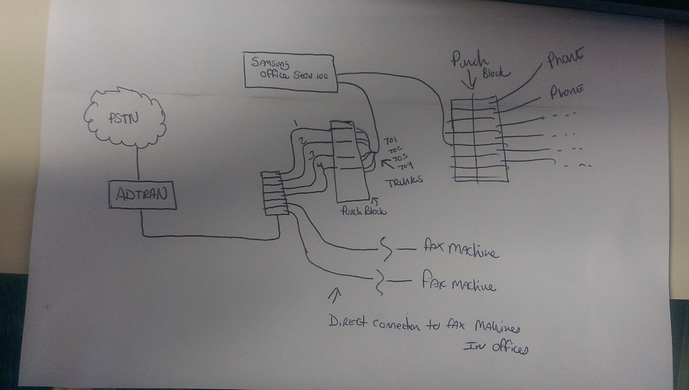The AdTran is acting as a channel bank - your T1 is split from 24 Channels into 6 discrete phone lines through that. Disconnecting that from the AdTran and plugging it into an Asterisk Server with a T1 termination card is doable.
If you really mean a 66-block and aren’t using the term as a generic punchdown block, then all of that stuff is useless in a new IP-Based phone system. It sounds like your Samsung is set up as a basic KSU with 6 incoming ports configured and a few digital phones attached.
http://www.samsung.com/ru/business/pdf/officeserv100/manual_12491.pdf is the documentation for your phone system.
After that, the flexibility of the Samsung system generates a series of challenges. From the documentation, it sounds like the system automatically identifies what kinds of phones are connected to each outgoing channel and they are managed internally. This means (from the “I’m not there, so I have no way of ever knowing” perspective) that you could be running any number of possible types of phones.
To duplicate your current system, you can use an Asterisk server set up with an 8-port (they usually come in multiples of 4) FXO card to take your six incoming lines and convert them to VOIP. If you’d rather, you can use a T1 terminus card and connect it in front of the AdTran - makes no difference EXCEPT for the FAX part (which, as you may recall, I said can be tricky with VOIP).
So, now you have to figure out what kinds of handsets you need. You have lots of choices, but it basically boils down to what you have and matching it to something that will work for you.
In this area, there are three distinct types of phones:
-
Digital phones that connect ONLY to your PBX - if I’m reading the docs right, the IDCS phones from the PDF are probably designed to only work with your PBX.
-
Single- or double-line POTS phones - the system appears to be able to do these, and there are some cases where they make sense. From your description, it wouldn’t surprise me if you had a few of these. This includes things like FAX lines, door phones, and other single-use, single-user applications.
-
VOIP phones - the system also appears to be able to communicate with VOIP phones. The upside is that you may be able to reuse the VOIP Phones in a new Asterisk based system. The downside is that they may have implemented a proprietary VOIP protocol. Won’t know until you get more information about the existing phones.
The fact that you’re using 66-blocks (and I assume you really mean 66-blocks) tells me that you probably are not using any of the VOIP capabilities, even though your wiring guy installed Cat-5 cable (same price as Cat-3 and he probably had it on hand, left over from another job).
If each instrument terminates on those punchdown blocks, it’s reasonable to assume that they are either digital phones (using two pairs each) or single lines (using a single pair). Knowing what you have connected to each pair (or set of pairs) will help you understand what your system is doing now.
In a perfect setup, you would identify each of the phones in the system and figure out what the suitable sub is for that phone. Of course, everyone has their preferences for specific instruments. I, for example, usually go for Cisco phones in SCCP mode. I can usually match up the functions needed from the old phones to a new phone and get you where you want to go. Others may suggest Sangoma’s new phone line (since FreePBX is owned by Sangoma now…).
Remember that you can also find and employ a 24-port FSX card and plug in up to 24 pots phones (or door phones…) in your Asterisk server (using a technology called DAHDI) and really duplicate what is there now (as well as reusing some of that 66-block wiring).
Your current system is complicated and will be hard to replicate, but only because this is your first foray into the technology. Since you are working between three campuses, you have to also take into account what equipment is installed there as well (we haven’t even scratched the surface yet). The advantage you have over me is that, based on your experience, you only have a hammer (SIP phones and trunks) so you can treat everything like a nail. 
Something that I say about once a week that sometimes helps is that installing an Asterisk system changes the way the phones logically connect to the world. There are no more “dedicated” lines in or out - the Asterisk system handles everything from the incoming calls to the intercom. Asterisk becomes the phone and what used to be the phones are now just really cool handsets. I started telling people this after I installed a phone system for a doctor’s office. One of the nurses thought she needed a “dedicated line” just for her. She couldn’t understand that, with VOIP, there’s no such thing. The only way a number is “dedicated” is because we tell Asterisk where to send the call.
I hope that helps.



